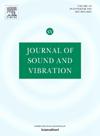Towards self-powered tunable mechanical oscillators: A conceptual study
IF 4.3
2区 工程技术
Q1 ACOUSTICS
引用次数: 0
Abstract
Mechanical oscillator resonance frequencies are of paramount importance and determine their performance from different perspectives such as bandwidth, vibration mitigation, and energy harvesting. As active tuning is hindered by energy consumption, this research investigates comprehensively for the first time if the inherent energy of a vibrating oscillator can supply the required energy to alter its natural frequency. To investigate the viability of this concept, a nonlinear partially covered piezoelectric beam-based oscillator with a full bridge rectifier and magnetic tuning mechanism under base excitation is considered, and its geometrically nonlinear model is derived. First, an approximate solution is proposed to study the capacitor charging process in steady-state excitation. Then, numerical integration and the multi- harmonic balance method (HBM) with pseudo-arclength continuation are exploited to investigate the nonlinear dynamics, mechanical response, and external capacitor voltage of the self-powered tunable oscillator (SPTOS). To investigate the sufficiency of the SPTOS energy for tuning, the required energy for different levels of change in the SPTOS natural frequency are obtained. It is found that the SPTOS can supply the energy to significantly change its natural frequency. The capacitor charging time and generated energy depend on the ratio of external capacitance to internal capacitance. The SPTOS efficiency under chirp excitation is then investigated, and the results show that both the chirp rate and the capacitance ratio affect the capacitor energy. Finally, by comparing the maxima of energy for the steady-state and chirp excitations, it is shown that the SPTOS energy in the former case is considerably higher than the latter case. Thus, the SPTOS can make larger changes in its frequency when excited in a steady-state scenario.
求助全文
约1分钟内获得全文
求助全文
来源期刊

Journal of Sound and Vibration
工程技术-工程:机械
CiteScore
9.10
自引率
10.60%
发文量
551
审稿时长
69 days
期刊介绍:
The Journal of Sound and Vibration (JSV) is an independent journal devoted to the prompt publication of original papers, both theoretical and experimental, that provide new information on any aspect of sound or vibration. There is an emphasis on fundamental work that has potential for practical application.
JSV was founded and operates on the premise that the subject of sound and vibration requires a journal that publishes papers of a high technical standard across the various subdisciplines, thus facilitating awareness of techniques and discoveries in one area that may be applicable in others.
 求助内容:
求助内容: 应助结果提醒方式:
应助结果提醒方式:


